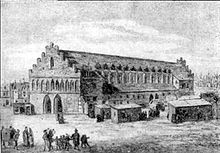Krakow Cloth Hall
The Kraków Cloth Hall - (Polish Sukiennice ) is located in the middle of the Main Market Square (Polish Rynek Główny ) in Kraków and is one of the most important examples of Renaissance architecture in Central Europe. They got their name after the trade in cloths .
History and description
The Cracow Cloth Hall was built in the Middle Ages at the instigation of King Casimir the Great . The covered buildings were used to trade in English and Flemish cloth , after which the halls were named. At night horse-drawn carts delivered new goods into the narrow passage between the general stores; the side entrances were barred with metal bars to protect against thieves.
In 1555 the Gothic building fell victim to a fire. When it was rebuilt in the Renaissance style, the cloth halls were given a barrel vault and a surrounding parapet with flat arcades and mascaron heads based on a design by the Italian Santi Gucci . Loggias were also built according to a design by Giovanni Maria Padovano and gas lighting , which was modern at the time, was installed. The halls occupy an area of 18 × 108 meters.
In 1601 a passage was created in the middle of the building, which improved the delivery of goods and the flow of customers.
In the years 1875–1878, the Cloth Hall was thoroughly rebuilt according to a design by the architect Tomasz Pryliński. The longitudinal sides received neo-Gothic arcades of Jan Matejko designed columns capitals . Exhibition rooms were created on the upper floor, which formed the first seat of the Kraków National Museum . Since the 20th century they have housed the gallery of Polish 19th century painting. Polish city coats of arms and guild symbols are affixed to the walls above the wooden stalls. Café Noworolski on the ground floor invites you to linger. Its interior is in Art Nouveau style and the walls are decorated with murals by Polish painters Henryk Uziembło and Józef Mehoffer .
In addition to the cloth hall, the city administration opened a new, underground museum on September 24, 2010. The archaeological excavations on the market square from 2004 to 2006 showed the walls of lost buildings from the Middle Ages. Instead of filling them up again, they were covered with a reinforced concrete slab and made accessible. They are a branch of the Kraków Historical Museum.
gallery
Web links
literature
- Mariusz Gotfryd, Krzysztof Lipiński, Sabine Lipiński: Krakow: Mini City Guide . Bosz, Olszanica 2007, ISBN 978-83-89747-84-6 .
- Izabella Gawin: Krakow: The Cloth Hall - Where trade is still flourishing today. The Wawel - where the royal palace and cathedral tower over the city. Travel House Media, Munich 2008, ISBN 978-3-8342-0338-0 (= Merian live! ).
Individual evidence
- ↑ Short biography of GMM Padovano ; accessed on May 26, 2015.
Coordinates: 50 ° 3 ′ 42.18 " N , 19 ° 56 ′ 14.53" E







